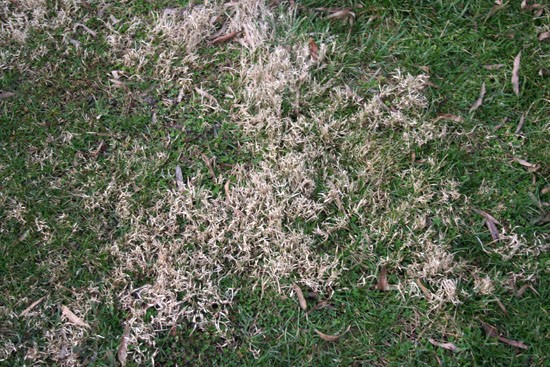Issue 1, April 22, 2021
Selective Control for Nimblewill
Nimblewill is a warm-season perennial grass that is fairly common in Illinois. Typically found growing in shady or wet lawns and landscapes, it creeps by aboveground, horizontal stems that can root at the nodes and readily form patches. Its leaves are smooth, quite narrow, and short compared to many grass species. Individual plants look almost wiry. In fact, another name for this grass is wire-grass. A closer look at this plant will reveal a very short, membranous, toothed ligule. The leaves are rolled in the bud. The flower is a fine, slender panicle.
Nimblewill patches are obvious now, as the cool-season grasses green up. Nimblewill, being a warm season-grass, is much slower to green up and goes dormant earlier in the fall. While dormant, its appearance is that of very light tan-colored, "puffed up" patches (the patches look like buff-colored scouring pads). When nimblewill greens up to a grayish- or bluish-green in late spring, its appearance is more inconspicuous. In Illinois, Nimblewill may be confused with zoysiagrass which has a similar growth pattern. However, dormant zoysiagrass is more of a golden tan in color and unless planted it is very unlikely for it to suddenly appear as a weed.

(Dormant nimblewill in actively growing turfgrass)
For many years, homeowners and professional lawncare applicators have had to rely on non-selective herbicides such as glyphosate when controlling nimblewill (Muhlenbergia schreberi) in residential lawns. Along with the nimblewill, non-target desirable plants such as bluegrass may be seriously injured or killed if contacted by glyphosate. Fortunately, we now have selective herbicide options for nimblewill.
Mesotrione (Tenacity, Meso 4SC, TRIONE, etc.) is labeled for use on most cool-season residential lawns. The active ingredient is mesotrione. It can control over 40 weed broadleaf and grass species including nutsedge. It can be used pre- or postemergence as well as at the time of seeding. Be sure to carefully read and follow all label directions. Take note of the maximum use rate and plan accordingly if making 3 applications. Spot treat patches of nimblewill with 2 to 3 applications (2 to 3 weeks apart) of mesotrione mixed with non-ionic surfactant. For optimal control, nimblewill should be treated when it is young and actively growing in the late spring to early summer. It is recommended that you extend spray coverage beyond the immediate patches as creeping stems are prone to lurk in these areas. Stolons missed by applications may form subsequent patches.
Avoid broadcast applications unless reseeding. Use a flat fan nozzle for even coverage. Affected plants will turn white as it is a bleaching herbicide. Whitening of turfgrass may last for several weeks which can be alarming to the uninformed. Be sure to prepare clients before using mesotrione on their lawn.
Mesotrione products labeled for turf are available in 8 oz. bottles. The use rate is quite low at 5 fl. oz. per acre. Additionally, mesotrione was granted "Reduced Risk" status by the EPA; compared to many registered herbicides it has favorable ecotoxicity and human health profiles.
Another selective option is topramezone (Pylex). This product is applied at an even lower use rate of 1 – 1.5 fl. oz. per acre at 21- to 28-day intervals. Tank mix with methylated seed oil or crop oil concentrate per label directions. Like mesotrione, topramezone also has a bleaching effect on susceptible species and a maximum allowed use rate per year. The cost is considerably higher than that of mesotrione but this product could be a good choice if bermudagrass is also a primary concern.
Many of our cool season turf grasses are dormant during hot summer days. Meanwhile, nimblewill is actively growing and enjoying the lack of competition. This unbalance can allow nimblewill to be a serious weed problem. Therefore, controlling patches while they are smaller is recommended. Proper cultural practices can significantly aid in controlling lawn weeds. Be sure that watering, fertilizing, and cultivating are done properly and at the right time.
Author:
Michelle Wiesbrook